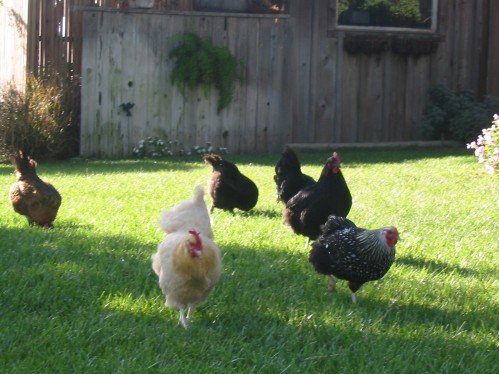 People always ask me about their hens and nesting boxes. How many nesting boxes to build for their number of hens. Why are all their hens using the same nesting box. Why does my hen lay her eggs outside and not in her nesting box. What are the best measurements for a hen's nesting box.
People always ask me about their hens and nesting boxes. How many nesting boxes to build for their number of hens. Why are all their hens using the same nesting box. Why does my hen lay her eggs outside and not in her nesting box. What are the best measurements for a hen's nesting box.
My response to everyone is borrowed from a wonderful framed poster I use to have of a colorful caricature of a big sassy reddish brown hen with the saying, "The sun has a right to set where it wants and so may I add as a hen." I use to interpret that poster as "follow your bliss in lIfe" and "be true to yourself."
Since I've experienced the wonderful world of backyard chickens for the last ten years or so, I realize that poster literally captured the essence of a happy laying hen. They naturally do their own thing, when it comes to laying their eggs.
Reaching into VintageGardenGal archives, I have written a detailed previous post on "Backyard Chicken Coop", "Nesting Boxes", with hen to nesting box ratios, measurements, ideal setting, and nesting box suggestions. However, when it come down to the personalities of your hens, they are literally going to lay their eggs where they please.
In general, if you provide a quiet clean side of your coop, protected from bright daylight sun, with nesting boxes slightly off of the chicken coop floor, your hens are naturally going to gravitate to a nesting box, and lay their eggs for you easily and effortlessly. Sometimes there is a favorite nesting box that your hens will prefer. Sometimes they will want to have a party, and all lay together in the same box. The point is with laying hens, just about anything is normal.
You might even have a hen that has a tendency to brood, a hen's natural way of incubating an egg by sitting on an egg(s) for days on end. If a hen has a healthy fertilized egg, and she sits on it faithfully for 21 days, she will hatch a chick. Hens can have brooding tendency with or without a rooster in the flock, and without fertilized eggs. It is called natural maternal instinct.
Hens work for very hard to lay an egg. Give them the freedom to lay where they like. Please share if you have any funny egg-laying stories from your flock.

 Hen nesting boxes are a way of organizing your hens and their business of egg-laying. If you do not provide nesting boxes, you could find eggs everywhere as if you were at an "Easter Egg Hunt". You wouldn't know where they were laid, or how fresh they were.
Hen nesting boxes are a way of organizing your hens and their business of egg-laying. If you do not provide nesting boxes, you could find eggs everywhere as if you were at an "Easter Egg Hunt". You wouldn't know where they were laid, or how fresh they were.

 Since I started writing about our chickens, there has been a lot of interest and questions on how to care for them. What are the components of a good chicken coop, and what kind of environment provided makes for healthy, happy, chickens. I think that many potential backyard enthusiasts would like to have chickens, but don't know what all is necessary to provide for them. I hope that I can clarify that for you.
Since I started writing about our chickens, there has been a lot of interest and questions on how to care for them. What are the components of a good chicken coop, and what kind of environment provided makes for healthy, happy, chickens. I think that many potential backyard enthusiasts would like to have chickens, but don't know what all is necessary to provide for them. I hope that I can clarify that for you.